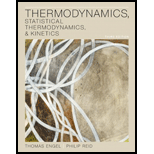
Thermodynamics, Statistical Thermodynamics, & Kinetics
3rd Edition
ISBN: 9780321824004
Author: ENGEL, Thomas/ Reid
Publisher: Pearson College Div
expand_more
expand_more
format_list_bulleted
Textbook Question
Chapter 3, Problem 3.12CP
Why are q and w not state functions?
Expert Solution & Answer
Want to see the full answer?
Check out a sample textbook solution
Students have asked these similar questions
If we assume a system with an anodic overpotential, the variation of n as a function
of current density:
1. at low fields is linear 2. at higher fields, it follows Tafel's law
Obtain the range of current densities for which the overpotential has the same value
when calculated for 1 and 2 cases (maximum relative difference of 5% compared to
the behavior for higher fields).
To which overpotential range does this correspond?
Data: i = 1.5 mA cm², T = 300°C, B = 0.64, R = 8.314 J K1 mol-1 and F = 96485 C mol-1.
Answer by equation please
Some of the theories used to describe interface structure can be distinguished by:1. the measured potential difference.2. the distribution of ions in solution.3. the calculation of charge density.4. the external Helmoltz plane.
Chapter 3 Solutions
Thermodynamics, Statistical Thermodynamics, & Kinetics
Ch. 3 - Prob. 3.1CPCh. 3 - Prob. 3.2CPCh. 3 - Prob. 3.3CPCh. 3 - Prob. 3.4CPCh. 3 - Why can qv be equated with a state function if q...Ch. 3 - Prob. 3.6CPCh. 3 - Prob. 3.7CPCh. 3 - Prob. 3.8CPCh. 3 - Prob. 3.9CPCh. 3 - Why is qv=U only for a constant volume process? Is...
Ch. 3 - Prob. 3.11CPCh. 3 - Why are q and w not state functions?Ch. 3 - Prob. 3.13CPCh. 3 - What is the relationship between a state function...Ch. 3 - Prob. 3.15CPCh. 3 - Is the following statement always, never, or...Ch. 3 - Is the following statement always, never, or...Ch. 3 - Prob. 3.18CPCh. 3 - Prob. 3.19CPCh. 3 - Is the expression UV=T2T1CVdT=nT1T2CV,mdT only...Ch. 3 - Prob. 3.1NPCh. 3 - Prob. 3.2NPCh. 3 - Prob. 3.3NPCh. 3 - Prob. 3.4NPCh. 3 - Prob. 3.5NPCh. 3 - Prob. 3.6NPCh. 3 - Integrate the expression =1/VV/TP assuming that ...Ch. 3 - Prob. 3.8NPCh. 3 - Prob. 3.9NPCh. 3 - Prob. 3.10NPCh. 3 - Prob. 3.11NPCh. 3 - Calculate w, q, H, and U for the process in which...Ch. 3 - Prob. 3.13NPCh. 3 - Prob. 3.14NPCh. 3 - Prob. 3.15NPCh. 3 - Prob. 3.16NPCh. 3 - Prob. 3.17NPCh. 3 - Prob. 3.18NPCh. 3 - Prob. 3.19NPCh. 3 - Prob. 3.20NPCh. 3 - Prob. 3.21NPCh. 3 - Prob. 3.22NPCh. 3 - Derive the following relation, UVmT=3a2TVmVm+b for...Ch. 3 - Prob. 3.24NPCh. 3 - Prob. 3.25NPCh. 3 - Prob. 3.26NPCh. 3 - Prob. 3.27NPCh. 3 - Prob. 3.28NPCh. 3 - Prob. 3.29NPCh. 3 - Prob. 3.30NPCh. 3 - Prob. 3.31NPCh. 3 - Prob. 3.32NPCh. 3 - Prob. 3.33NPCh. 3 - Prob. 3.34NPCh. 3 - Derive the equation H/TV=CV+V/k from basic...Ch. 3 - Prob. 3.36NPCh. 3 - Prob. 3.37NPCh. 3 - Show that CVVT=T2PT2VCh. 3 - Prob. 3.39NP
Knowledge Booster
Learn more about
Need a deep-dive on the concept behind this application? Look no further. Learn more about this topic, chemistry and related others by exploring similar questions and additional content below.Similar questions
- When talking about the acidity of carboxylic acids, is it the same thing to say higher or stronger acidity?arrow_forwardUsing the following two half-reactions, determine the pH range in which $NO_2^-\ (aq)$ cannot be found as the predominant chemical species in water.* $NO_3^-(aq)+10H^+(aq)+8e^-\rightarrow NH_4^+(aq)+3H_2O(l),\ pE^{\circ}=14.88$* $NO_2^-(aq)+8H^+(aq)+6e^-\rightarrow NH_4^+(aq)+2H_2O(l),\ pE^{\circ}=15.08$arrow_forwardIndicate characteristics of oxodec acid.arrow_forward
- What is the final product when hexanedioic acid reacts with 1º PCl5 and 2º NH3.arrow_forwardWhat is the final product when D-galactose reacts with hydroxylamine?arrow_forwardIndicate the formula of the product obtained by reacting methyl 5-chloro-5-oxopentanoate with 1 mole of 4-penten-1-ylmagnesium bromide.arrow_forward
arrow_back_ios
SEE MORE QUESTIONS
arrow_forward_ios
Recommended textbooks for you
 Chemistry for Engineering StudentsChemistryISBN:9781337398909Author:Lawrence S. Brown, Tom HolmePublisher:Cengage Learning
Chemistry for Engineering StudentsChemistryISBN:9781337398909Author:Lawrence S. Brown, Tom HolmePublisher:Cengage Learning ChemistryChemistryISBN:9781305957404Author:Steven S. Zumdahl, Susan A. Zumdahl, Donald J. DeCostePublisher:Cengage Learning
ChemistryChemistryISBN:9781305957404Author:Steven S. Zumdahl, Susan A. Zumdahl, Donald J. DeCostePublisher:Cengage Learning Chemistry: An Atoms First ApproachChemistryISBN:9781305079243Author:Steven S. Zumdahl, Susan A. ZumdahlPublisher:Cengage Learning
Chemistry: An Atoms First ApproachChemistryISBN:9781305079243Author:Steven S. Zumdahl, Susan A. ZumdahlPublisher:Cengage Learning
 Physical ChemistryChemistryISBN:9781133958437Author:Ball, David W. (david Warren), BAER, TomasPublisher:Wadsworth Cengage Learning,
Physical ChemistryChemistryISBN:9781133958437Author:Ball, David W. (david Warren), BAER, TomasPublisher:Wadsworth Cengage Learning, World of ChemistryChemistryISBN:9780618562763Author:Steven S. ZumdahlPublisher:Houghton Mifflin College Div
World of ChemistryChemistryISBN:9780618562763Author:Steven S. ZumdahlPublisher:Houghton Mifflin College Div

Chemistry for Engineering Students
Chemistry
ISBN:9781337398909
Author:Lawrence S. Brown, Tom Holme
Publisher:Cengage Learning

Chemistry
Chemistry
ISBN:9781305957404
Author:Steven S. Zumdahl, Susan A. Zumdahl, Donald J. DeCoste
Publisher:Cengage Learning

Chemistry: An Atoms First Approach
Chemistry
ISBN:9781305079243
Author:Steven S. Zumdahl, Susan A. Zumdahl
Publisher:Cengage Learning


Physical Chemistry
Chemistry
ISBN:9781133958437
Author:Ball, David W. (david Warren), BAER, Tomas
Publisher:Wadsworth Cengage Learning,

World of Chemistry
Chemistry
ISBN:9780618562763
Author:Steven S. Zumdahl
Publisher:Houghton Mifflin College Div
The Laws of Thermodynamics, Entropy, and Gibbs Free Energy; Author: Professor Dave Explains;https://www.youtube.com/watch?v=8N1BxHgsoOw;License: Standard YouTube License, CC-BY